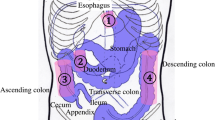Abstract
Computed tomography (CT) is an effective, readily available diagnostic imaging tool for evaluation of the emergency room (ER) patients with the clinical suspicion of perianal abscess and/or infected fistulous tract (anorectal sepsis). These patients usually present with perineal pain, fever, and leukocytosis. The diagnosis can be easy if the fistulous tract or abscess is visible on inspection of the perianal skin. If the tract or abscess is deep, then the clinical diagnosis can be difficult. Also, the presence of complex tracts or supralevator extension of the infection cannot be judged by external examination alone. Magnetic resonance imaging (MRI) is the best imaging test to accurately detect fistulous tracts, especially when they are complex (Omally et al. in AJR 199:W43–W53, 2012). However, in the acute setting in the ER, this imaging modality is not always immediately available. Endorectal ultrasound has also been used to identify perianal abscesses, but this modality requires hands-on expertise and can have difficulty localizing the offending fistulous tract. It may also require the use of a rectal probe, which the patient may not be able to tolerate. Contrast-enhanced CT is a very useful tool to diagnose anorectal sepsis; however, this has not received much attention in the recent literature (Yousem et al. in Radiology 167(2):331–334, 1988) aside from a paper describing CT imaging following fistulography (Liang et al. in Clin Imaging 37(6):1069–1076, 2013). An infected fistula is indicated by a fluid-/air-filled soft tissue tract surrounded by inflammation. A well-defined round to oval-shaped fluid/air collection is indicative of an abscess. The purpose of this article is to demonstrate the usefulness of contrast-enhanced CT in the diagnosis of acute anorectal sepsis in the ER setting. We will discuss the CT appearance of infected fistulous tracts and abscesses and how CT imaging can guide the ER physician in the clinical management of these patients.














Similar content being viewed by others
References
Omally RB, Al-Hawary MM, Wasnik AP, Liu PS, Hussian HK (2012) Rectal imaging: part 2, perianal fistula evaluation on pelvic MRI—what the radiologist needs to know. AJR 199:W43–W53
Yousem DM, Fishman EK, Jones B (1988) Crohn disease: perirectal and perianal findings at CT. Radiology 167(2):331–334
Liang C, Jiang W, Zhao B, Zhang Y, Du Y, Lu Y (2013) CT imaging with fistulography for perianal fistula: does it really help the surgeon? Clin Imaging 37(6):1069–1076
Hyman N (1999) Anorectal abscess and fistula. Prim Care 26(1):69–80
Gage KL, Deshmukh S, Macura KJ, Kamel IR, Zaheer A (2013) MRI of perianal fitulas: bridging the radiological–surgical divide. Abdom Imaging 38:1033–1042
Seow-Choen F, Hay AJ, Heard S, Phillips RK (1992) Bacteriology of anal fistulae. Br J Surg 79(1):27–28
Barleben A, Mills S (2010) Anorectal anatomy and physiology. Surg Clin N Am 90:1–15
Gunn ML, Kohr JR (2010) State of the art: technologies for computed tomography dose reduction. Emerg Radiol 17(3):209–218
Kalra MK, Rizzo SM, Novelline RA (2005) Reducing radiation dose in emergency computed tomography with automatic exposure control techniques. Emerg Radiol 11(5):267–274
Rickard MJFX (2005) Anal abscesses and fistulas. ANZ J Surg 75:64–72
Rizzo JA, Naig AL, Johnson EK (2010) Anorectal abcess and fistula-in-ano: evidence-based management. Surg Clin N Am 90:45–68
Whiteford MH (2007) Perianal abscess/fistula disease. Clin Colon Rectal Surg 20:102–109
Ziech M, Felt-Bersma R, Stoker J (2009) Clinical imaging. Clin Gastroenterol Hepatol 7:1037–1045
Nimikos IN (1997) Anorectal abscesses: need for accurate anatomical localization of the disease. Clin Anat 10:239–244
Parks AG, Gordon PH, Hardcastle JD (1976) A classification of fistula-in-ano. Br J Surg 63(1):1–12
de Miguel CJ, del Salto LG, Rivas PF, del Hoyo LF, Velasco LG, de las Vacas MI, Marco Sanz AG, Paradela MM, Moreno EF (2012) MR imaging evaluation of perianal fistulas: spectrum of imaging features. RadioGraphics 32:175–194
Conflict of interest
The authors declare that they have no conflict of interest.
Author information
Authors and Affiliations
Corresponding author
Rights and permissions
About this article
Cite this article
Khati, N.J., Sondel Lewis, N., Frazier, A.A. et al. CT of acute perianal abscesses and infected fistulae: a pictorial essay. Emerg Radiol 22, 329–335 (2015). https://doi.org/10.1007/s10140-014-1284-3
Received:
Accepted:
Published:
Issue Date:
DOI: https://doi.org/10.1007/s10140-014-1284-3




